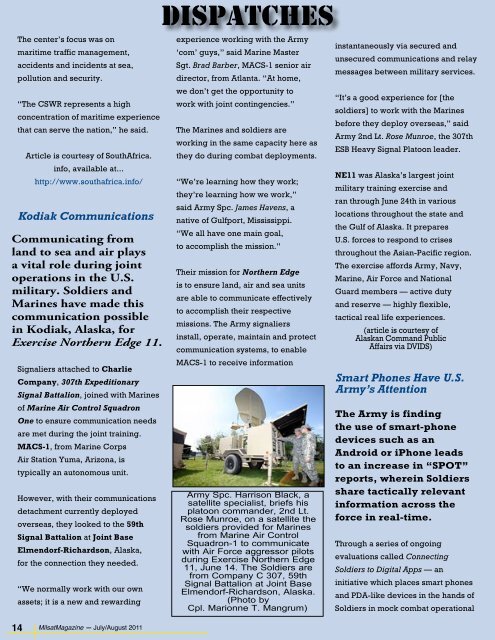Emergency Communications C-COM, Hughes Boeing — GPS II-F ...
Emergency Communications C-COM, Hughes Boeing — GPS II-F ...
Emergency Communications C-COM, Hughes Boeing — GPS II-F ...
Create successful ePaper yourself
Turn your PDF publications into a flip-book with our unique Google optimized e-Paper software.
14<br />
The center’s focus was on<br />
maritime traffic management,<br />
accidents and incidents at sea,<br />
pollution and security.<br />
“The CSWR represents a high<br />
concentration of maritime experience<br />
that can serve the nation,” he said.<br />
Article is courtesy of SouthAfrica.<br />
info, available at...<br />
http://www.southafrica.info/<br />
Kodiak <strong>Communications</strong><br />
Communicating from<br />
land to sea and air plays<br />
a vital role during joint<br />
operations in the U.S.<br />
military. Soldiers and<br />
Marines have made this<br />
communication possible<br />
in Kodiak, Alaska, for<br />
Exercise Northern Edge 11.<br />
Signaliers attached to Charlie<br />
Company, 307th Expeditionary<br />
Signal Battalion, joined with Marines<br />
of Marine Air Control Squadron<br />
One to ensure communication needs<br />
are met during the joint training.<br />
MACS-1, from Marine Corps<br />
Air Station Yuma, Arizona, is<br />
typically an autonomous unit.<br />
However, with their communications<br />
detachment currently deployed<br />
overseas, they looked to the 59th<br />
Signal Battalion at Joint Base<br />
Elmendorf-Richardson, Alaska,<br />
for the connection they needed.<br />
“We normally work with our own<br />
assets; it is a new and rewarding<br />
MilsatMagazine <strong>—</strong> July/August 2011<br />
disPatches<br />
experience working with the Army<br />
‘com’ guys,” said Marine Master<br />
Sgt. Brad Barber, MACS-1 senior air<br />
director, from Atlanta. “At home,<br />
we don’t get the opportunity to<br />
work with joint contingencies.”<br />
The Marines and soldiers are<br />
working in the same capacity here as<br />
they do during combat deployments.<br />
“We’re learning how they work;<br />
they’re learning how we work,”<br />
said Army Spc. James Havens, a<br />
native of Gulfport, Mississippi.<br />
“We all have one main goal,<br />
to accomplish the mission.”<br />
Their mission for Northern Edge<br />
is to ensure land, air and sea units<br />
are able to communicate effectively<br />
to accomplish their respective<br />
missions. The Army signaliers<br />
install, operate, maintain and protect<br />
communication systems, to enable<br />
MACS-1 to receive information<br />
Army Spc. Harrison Black, a<br />
satellite specialist, briefs his<br />
platoon commander, 2nd Lt.<br />
Rose Munroe, on a satellite the<br />
soldiers provided for Marines<br />
from Marine Air Control<br />
Squadron-1 to communicate<br />
with Air Force aggressor pilots<br />
during Exercise Northern Edge<br />
11, June 14. The Soldiers are<br />
from Company C 307, 59th<br />
Signal Battalion at Joint Base<br />
Elmendorf-Richardson, Alaska.<br />
(Photo by<br />
Cpl. Marionne T. Mangrum)<br />
instantaneously via secured and<br />
unsecured communications and relay<br />
messages between military services.<br />
“It’s a good experience for [the<br />
soldiers] to work with the Marines<br />
before they deploy overseas,” said<br />
Army 2nd Lt. Rose Munroe, the 307th<br />
ESB Heavy Signal Platoon leader.<br />
NE11 was Alaska’s largest joint<br />
military training exercise and<br />
ran through June 24th in various<br />
locations throughout the state and<br />
the Gulf of Alaska. It prepares<br />
U.S. forces to respond to crises<br />
throughout the Asian-Pacific region.<br />
The exercise affords Army, Navy,<br />
Marine, Air Force and National<br />
Guard members <strong>—</strong> active duty<br />
and reserve <strong>—</strong> highly flexible,<br />
tactical real life experiences.<br />
(article is courtesy of<br />
Alaskan Command Public<br />
Affairs via DVIDS)<br />
Smart Phones Have U.S.<br />
Army’s Attention<br />
The Army is finding<br />
the use of smart-phone<br />
devices such as an<br />
Android or iPhone leads<br />
to an increase in “SPOT”<br />
reports, wherein Soldiers<br />
share tactically relevant<br />
information across the<br />
force in real-time.<br />
Through a series of ongoing<br />
evaluations called Connecting<br />
Soldiers to Digital Apps <strong>—</strong> an<br />
initiative which places smart phones<br />
and PDA-like devices in the hands of<br />
Soldiers in mock combat operational


